Projects are listed in no specific order.
Pen House
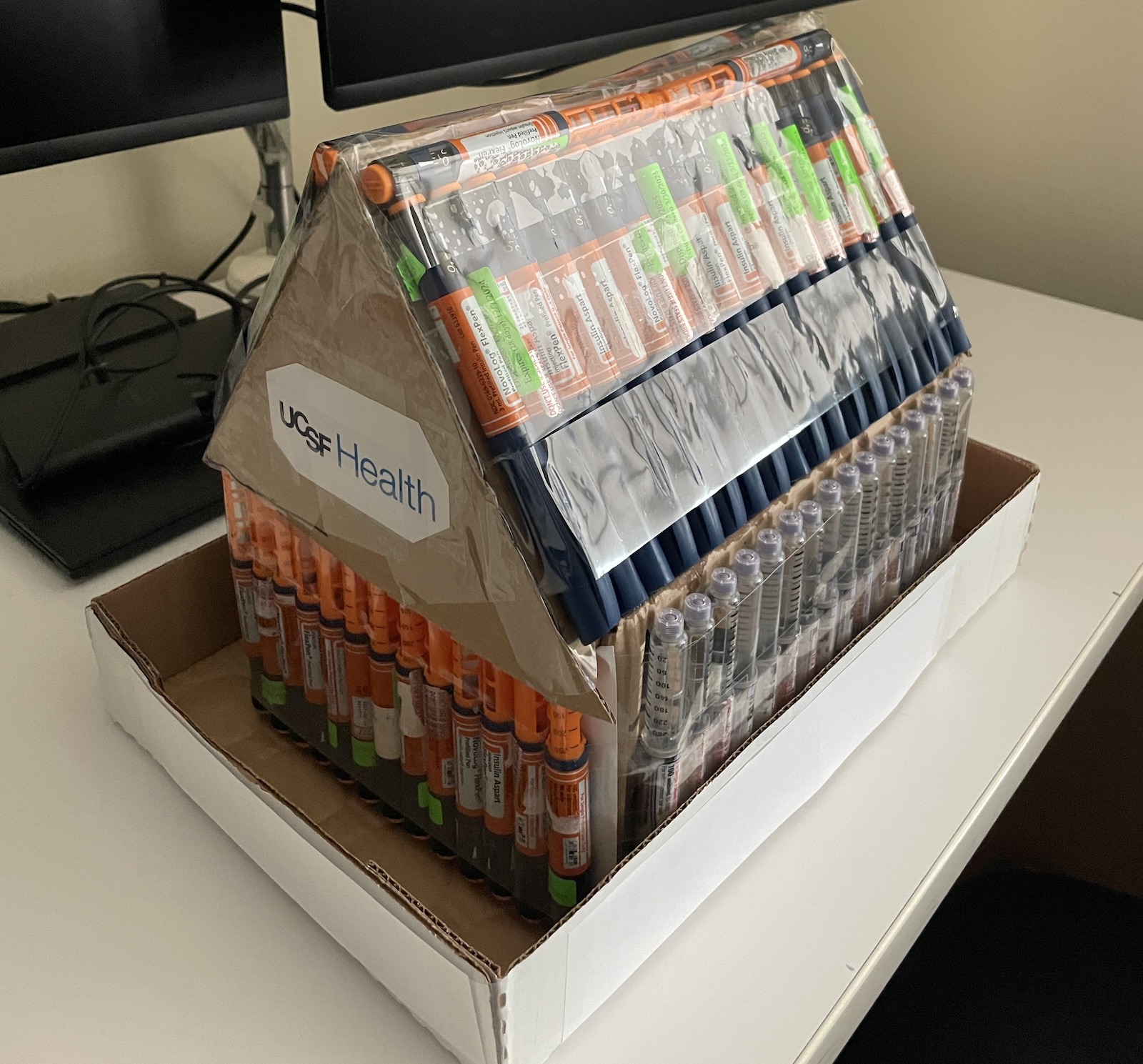
Insulin is an essential medication needed to manage diabetes. It is also expensive and there is not an endless supply of this medication. In FY 23, there were over 5000 insulin pens wasted potentially due to inefficient practices around dispensing and transferring medications when patients move across units. Through multiple interventions, we reduced the amount of insulin pen waste by 19% in FY 24. However, this medication waste is not limited to insulin but other bulk medications (i.e. multi-use medications) as well. At the end of every hospital stay, all bulk medications are discarded resulting in financial waste as well as potential environmental harm.
I was inspired to create this art piece to highlight and call attention to this problem of bulk medication waste, specifically insulin waste to bring awareness to this issue. I collected discarded insulin pens and used them to construct this “pen house” which is constructed in the shape of a house – more like a hospital, i.e. UCSF.
I hope that this piece will cause healthcare providers to consider what steps they can take individually as well as organizationally to use scarce healthcare resources judiciously.
By Esther Rov-Ikpah
A Tribute to Anesthesiologists – The Silent Guardians
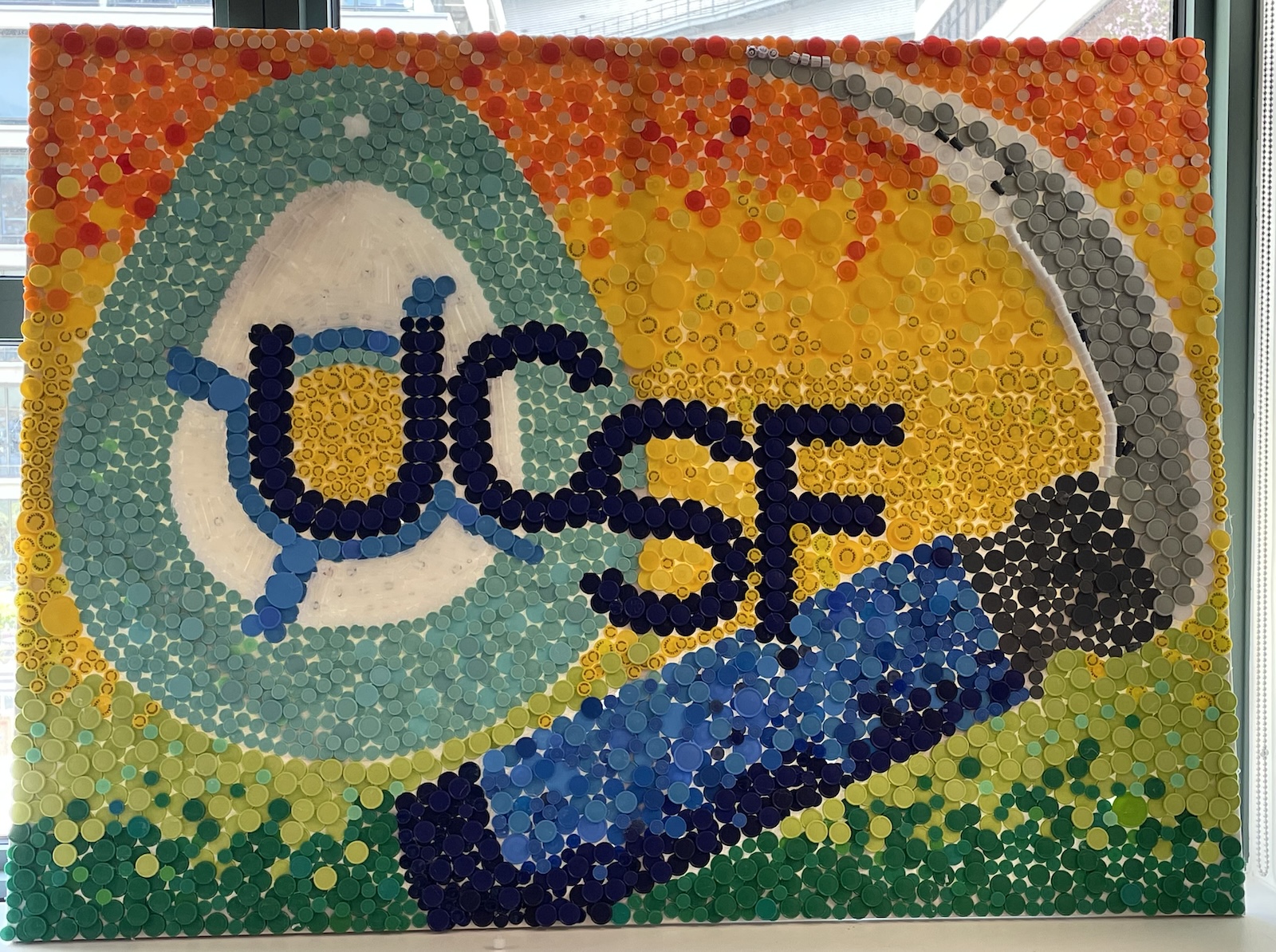
Every year, the Department of Anesthesia collectively collects the colorful medication vial caps that are otherwise going into landfills to create beautiful art pieces filled with creativity and imagination. This year, we pay tribute to our anesthesiologists for their dedication to advancing healthcare. The canvas is made from medication vial caps and depicts the two most commonly used items in anesthesia, the oxygen mask and the laryngoscope used for intubation.
Anesthesiologists are the silent guardians of the operating rooms and the critical care wards, ensuring patients experience surgeries and life-threatening illnesses without pain or fear. They are the ultimate team players, working collaboratively with surgeons, nurses, and other healthcare professionals to ensure safety and provide the best experience for patients. Their deep expertise and unwavering vigilance make complex medical procedures possible, safeguarding lives with every breath they monitor.
In the context of today’s healthcare, unfortunately, both oxygen masks and laryngoscopes are single-use. Medication waste is also common in the practice of anesthesia. We would like to raise more awareness about waste generation in anesthesia practices and the medical field, and work jointly towards a future with less waste
By Hemra Cil, Elizabeth Whitlock, Kaiyi Wang, Seema Gandhi
SANKOFA

This piece uses over 1,500 hand-selected and trimmed syringe medication labels as its
primary color medium to form the Pan-African flag, designed by Marcus Garvey in 1920,
to represent and unite people of African descent. The work reclaims hospital waste,
transforming it into a layered reflection on identity, responsibility, and collective
healing.
At the center is a gold spray-painted rendering of the West African Adinkra symbol Sankofa, shaped from discarded rocuronium lids and tubing end caps. In this piece, they become Morse code: dots made from small vial tops, dashes from combining two tubing caps, and medium vial tops separate words. Moving clockwise from the bottom left swirl, the left half of the heart spells “I am part of the problem,” and the right half, “I am part of the solution.” The medium choice and layout echo the Sankofa meaning: to look back in order to move forward.
This artwork questions the dual roles we each play in systems we inhabit—especially within medicine—and challenges the viewer to engage with both complicity and possibility. It also honors the unseen labor of hospital staff and the value of materials typically discarded without a second thought.
Special thanks to the Anesthesia Technicians at UCSF Parnassus for rescuing and saving the labels that made this project possible.
By Charlene M. Blake, MD, PhD
The Operating Theatre
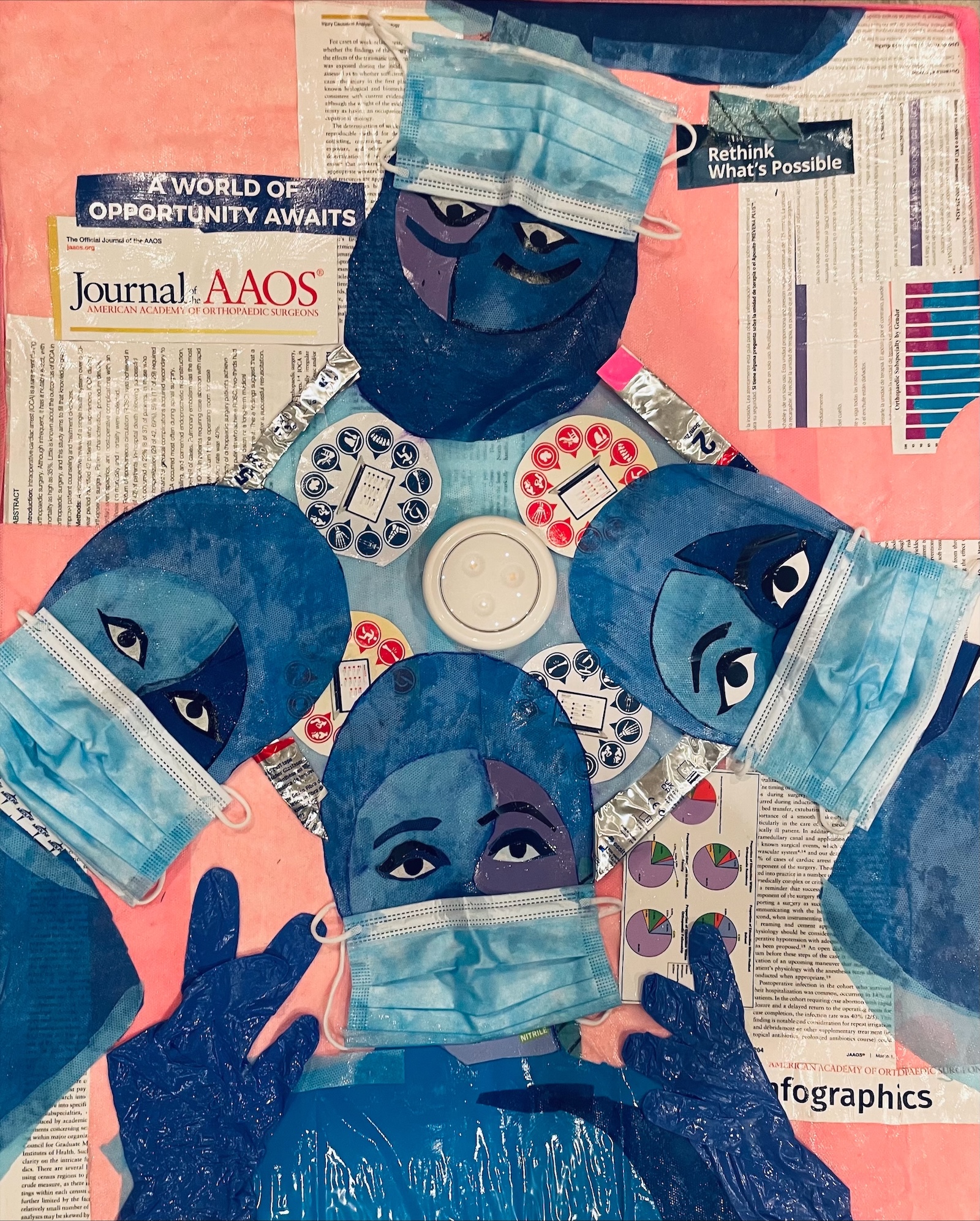
In 2017, the New Yorker released a cover by Malika Favre capturing the patient’s perspective moments before surgery. Her depiction of an all-female team resonated with other surgeons across the world, Surgical teams began to replicate the image under the hashtag #ILookLikeASurgeon, bringing visibility to women and other minority groups working in traditionally white, male-dominated fields.
We sought to recreate this iconic scene. We began by using plaster and cast fiberglass to create a canvas. We then layered on operating room supplies (gloves, blue sheets, autoclave packaging) as well as news clippings from the latest edition of the Journal of Academic Association of Orthopedics (JAAOS), with a special focus on articles regarding diversity, equity and inclusion. Despite promising strides towards gender representation, in 2019, women still only constituted 15.4 % of orthopedic surgery residents, 19.9% of faculty, and 9 % of program directors. Lastly, we included a central shining light powered by batteries from OR tools that are commonly disposed of after the case. Our piece is an homage to the #ILookLikeASurgeon movement and a nod to the power of a more diverse workforce.
With love and hope,
By Doctors and orthopedic surgeons: Angel Xiao, Alicia Asturias, Rosanna Wustrack
Evolving Elements
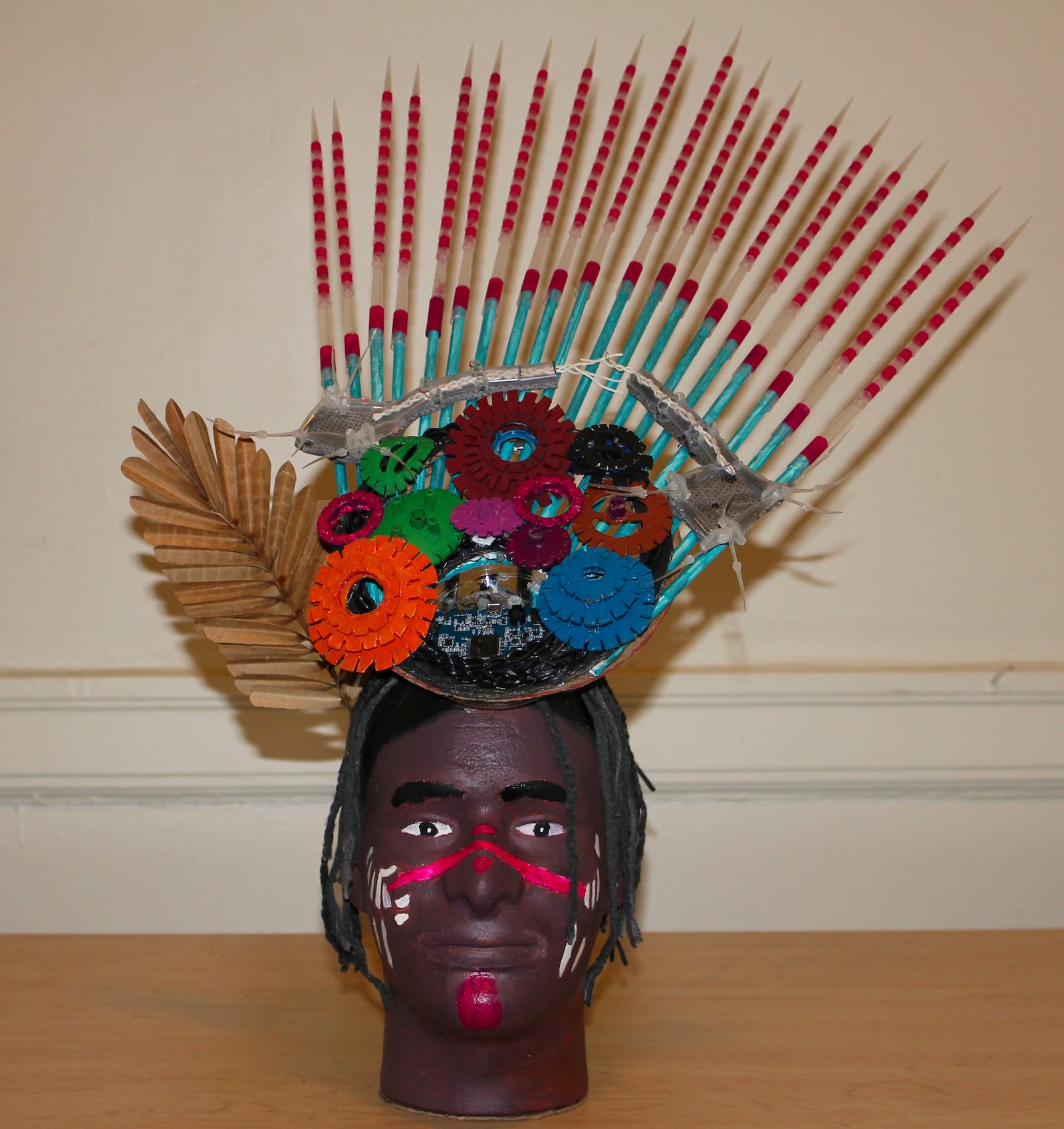
Used Materials: This piece is crafted from a diverse array of discarded materials, primarily sourced from a molecular biology laboratory. These include tip racks, pipette tips (20μl, 200μl, and 1ml), PCR tubes (0.2 and 0.5ml), and agar plates. Additional elements incorporate discarded electric wires and circuits, paper, cardboard, and waste fabric/cloth.
The gear-like base, reshaped from tip racks, represents scientific innovation and symbolizes the turning wheels of discovery.
The agar plate culture dish grounds the artwork and contains an electric circuit,
highlighting the convergence of life sciences and technology.
Neuronal cells crafted from PCR tubes and tips pay homage to the human mind as the engine of progress.
The crown, formed from painted pipette tips, provides a dynamic visual element, transforming everyday lab items into an aesthetic feature.
A "feather" - itself crafted from waste - alongside a face painted with echoes of indigenous heritage and a contemporary hairstyle represents human evolution, illustrating our journey from past to present. It's a reminder that while we embrace new frontiers, we are also connected to our past.
"Evolving Elements" is an invitation to see waste not as an end, but as a potential beginning.
By Ahmed Amine Mergani
Chained Link
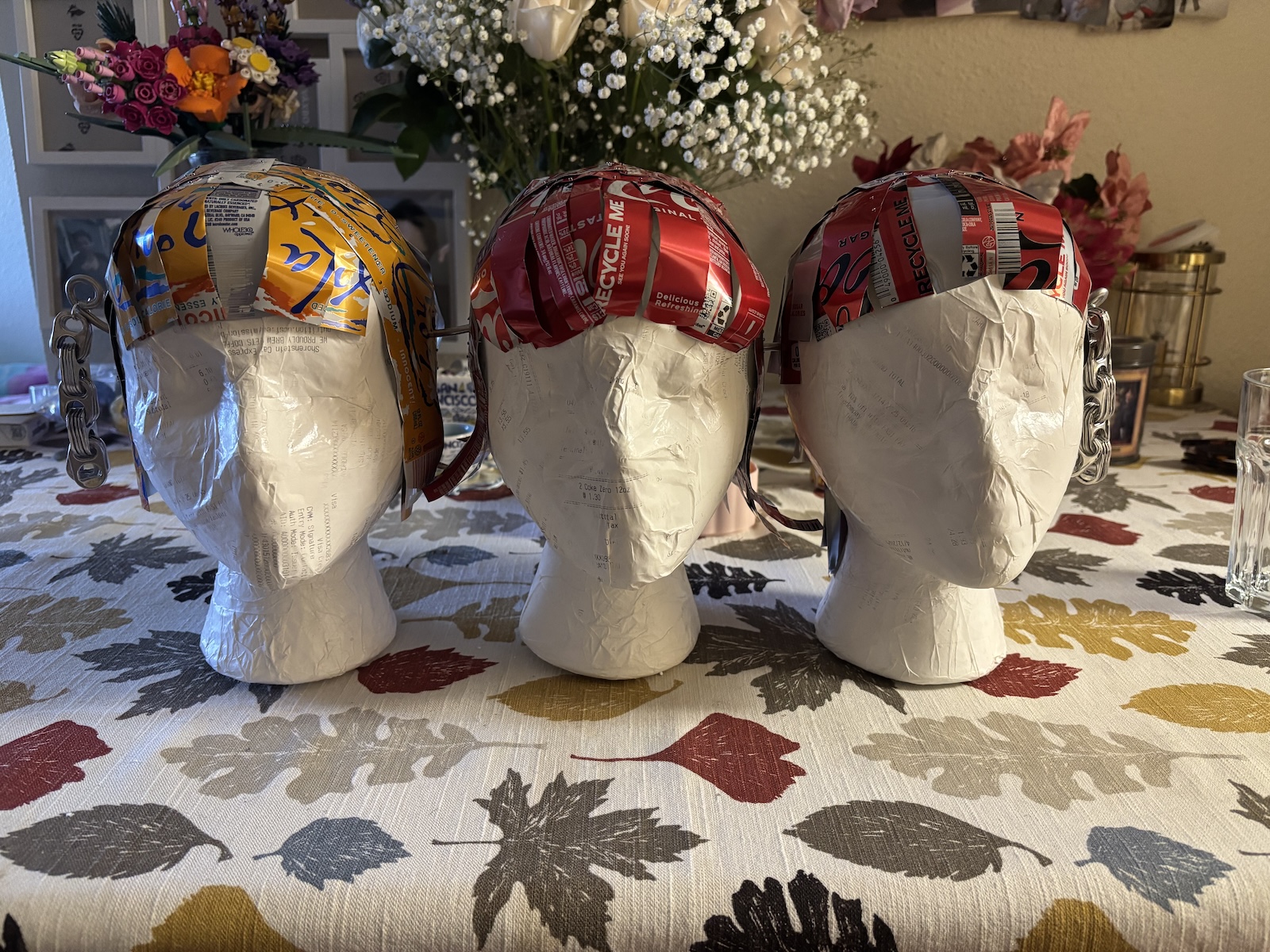 I am constantly inspired by the women in my life, so using receipts and cans found in the cafeteria I made busts of three fashion forward women. They each have their own unique style but are chained together by a soda tab chain and heavy wire.
I am constantly inspired by the women in my life, so using receipts and cans found in the cafeteria I made busts of three fashion forward women. They each have their own unique style but are chained together by a soda tab chain and heavy wire.
They are united as women and as consumers; buying anything in the cafeterias or cafes at UCSF campuses will give you a non-negotiable receipt which causes endless waste. The cans used are from diet sodas and sparkling water collected from Shorenstein Family Cafe at UCSF Mission Bay.
By Serenity Martel
Keep Rising
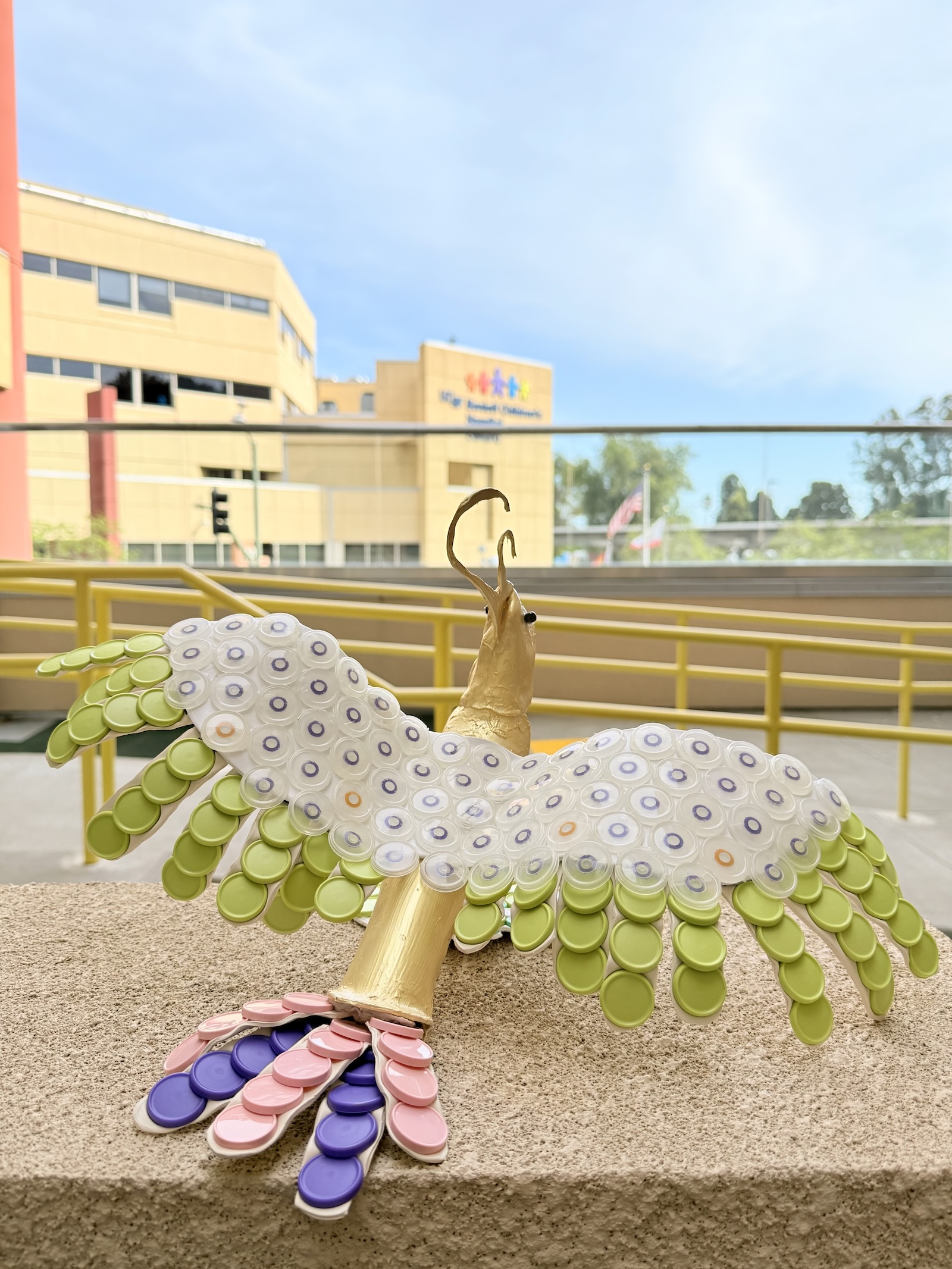 As rehabilitation providers (physiatrists, physical therapists, occupational therapists, speech therapists, and rehabilitation nurses), we care for patients who have faced life-changing injuries and illnesses. Our goal is to help in functional recovery, but also to provide our patients the tools with which they can start to rebuild their lives. The phoenix represents resilience and transformation emergingfrom adversity – which we witness daily in our patients and families’ journeys.
As rehabilitation providers (physiatrists, physical therapists, occupational therapists, speech therapists, and rehabilitation nurses), we care for patients who have faced life-changing injuries and illnesses. Our goal is to help in functional recovery, but also to provide our patients the tools with which they can start to rebuild their lives. The phoenix represents resilience and transformation emergingfrom adversity – which we witness daily in our patients and families’ journeys.
The phoenix has also been a figurehead of comfort and inspiration for humans in transition throughout the ages. Our Pediatric Rehabilitation Division has undergone many transitions in recent years, still facing more transitions and challenges ahead. However, we remain, privileged to care for our patients and
steadfast in our vision of growing our Pediatric Rehabilitation program to one that is recognized nationally and internationally, while staying true to our mission of providing excellent rehabilitation care to our immediate community including the most vulnerable populations.
We created a phoenix sculpture out of waste generated in our Rehabilitation Clinic. Thermoplast scraps - material left over after fabrication of orthoses (ankle foot orthoses, wrist and hand splints) were used to create the base structure, and bottle caps from botulinum toxin and normal saline bottles were used to create the feathers for its wings and tail.
By Yumi Mitsuya MD, Kayla Williams MD, Megan Karburn OTR/L Pediatric Rehabilitation, BCH-Oakland Department of Orthopedic Surgery
Here there be Garbage
 Materials: Desiccant (silica packets), salt, sugar, acrylic, cardboard, pipette tips, various compostable plant materials, epoxy resin, screws, glass
Materials: Desiccant (silica packets), salt, sugar, acrylic, cardboard, pipette tips, various compostable plant materials, epoxy resin, screws, glass
The premise of the piece started with a discarded box found along Ocean Beach, and evolved with various bits and pieces of waste that I found walking along the beach. The application of salt/sugar water was done in consideration of the amount of liquid waste (ie, buffers) that labs incidentally produce, and the various food/solid waste that is produced at conferences (ie, coffee cups, mixing sticks, etc). The larger formulation of the piece as a re-imagined ocean map was done in consideration to the idea of what future or past explorers in the Pacific Ocean might think/have thought upon encountering the Great Pacific Garbage Patch.
By Kenneth Huang
Plastic Reef: Transplant
 Plastic Reef: Transplant is an artwork in my series on bleaching of the coral reefs. The burning of fossil fuels results in global warming. An increase in ocean temperature, as little as 2° Fahrenheit, can be deadly for coral reef systems. Corals form a mutualistic relationship with the algae zooxanthellae. Warmer temperatures cause them to expel the algae and, if sustained, eventually kills the corals. Instead of stunning colors, a skeleton is left behind. I use plastic discards to create imaginary reef “organisms.” In my earlier works, I created “organisms” out of white plastic discards to simulate bleaching. My later works are made from all colors of plastic to additionally indicate how our widespread use of plastics are polluting our oceans and the planet.
Plastic Reef: Transplant is an artwork in my series on bleaching of the coral reefs. The burning of fossil fuels results in global warming. An increase in ocean temperature, as little as 2° Fahrenheit, can be deadly for coral reef systems. Corals form a mutualistic relationship with the algae zooxanthellae. Warmer temperatures cause them to expel the algae and, if sustained, eventually kills the corals. Instead of stunning colors, a skeleton is left behind. I use plastic discards to create imaginary reef “organisms.” In my earlier works, I created “organisms” out of white plastic discards to simulate bleaching. My later works are made from all colors of plastic to additionally indicate how our widespread use of plastics are polluting our oceans and the planet.
Plastic Reef: Transplant is made from plastic discards generated by treatment I needed after my lung transplant. I decrease as much as possible the plastic I use in my life. However, these treatments are necessary for my survival, causing a conflict with my principles.
By Ruth Tabancay
Second Bloom
 We created this piece to showcase some of our sustainability waste diversion programs in the form of a garden. We used supplies from the blue wrap recycling program, surplus medical donation program, and the e-waste recycling program to create a variety of flowers and garden creatures.
We created this piece to showcase some of our sustainability waste diversion programs in the form of a garden. We used supplies from the blue wrap recycling program, surplus medical donation program, and the e-waste recycling program to create a variety of flowers and garden creatures.
Blue wrap recycling helps reduce waste in the OR. Blue wrap is made of polypropylene and cannot be accepted by our recycling waste hauler. We partner with a vendor who collects our blue wrap, pelletizes it, and creates new products. This diverts about 9,000 lbs a year.
Surplus medical supplies: We partner with humanitarian aid organizations to get surplus medical supplies to those in need. UCSF staff can drop off unused, unopened, and unexpired supplies at the Parnassus, Mission Bay, and Mount Zion medical centers. In FY25, we have diverted 977 pounds of usable medical supplies from the landfill.
E-waste collection was one of the first diversion programs established by the Health Sustainability team. E-waste is hazardous waste because the components include heavy metals, which contaminate the environment. We host monthly collection events, ensuring that staff have a safe and easy way to dispose of their electronics.
By Isabel Navarrete and Mikayla White
Ransom Note from the Planet
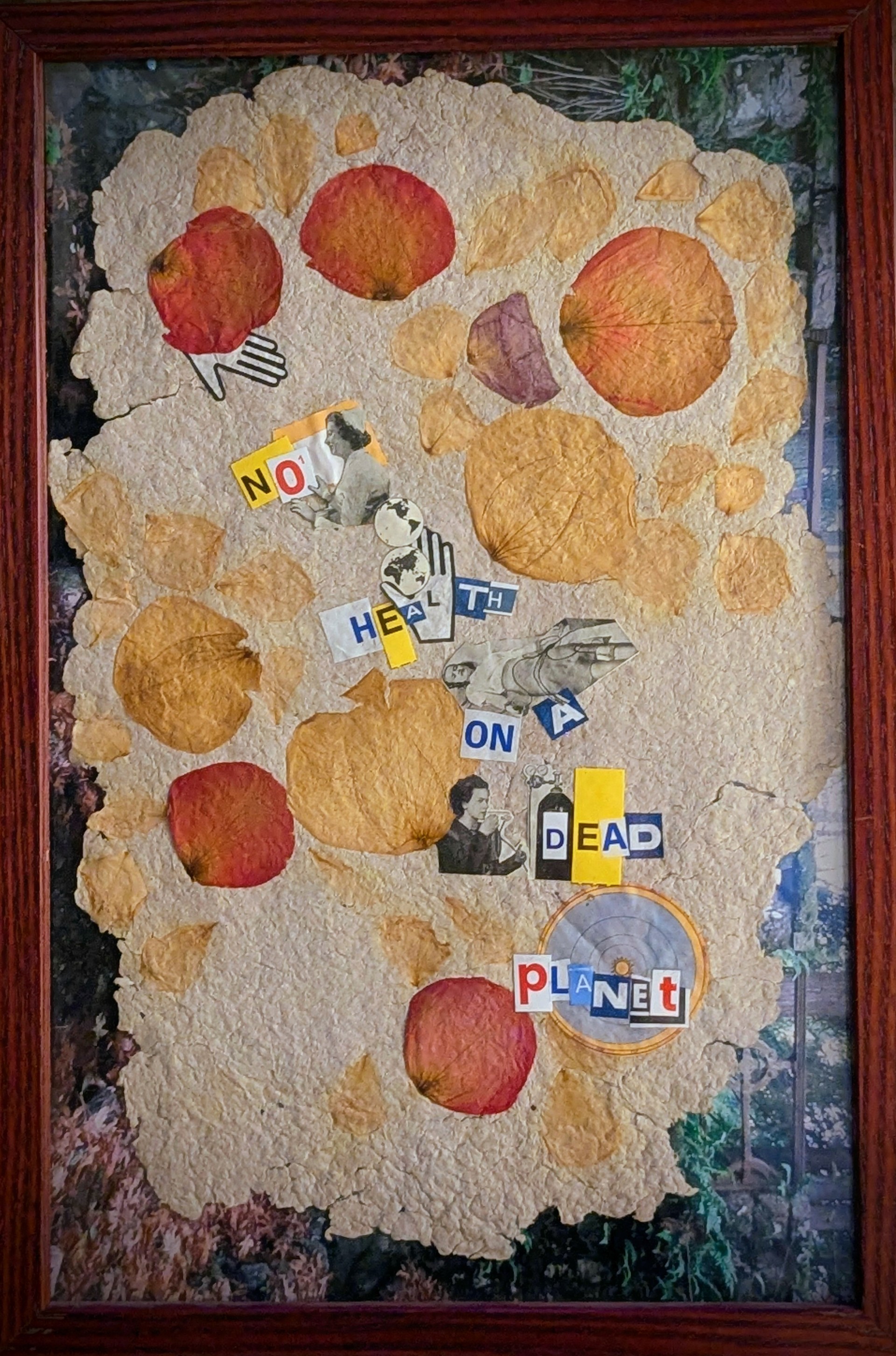
This ransom note-styled piece considers earth's perspective. The piece reads “No health on a dead planet,” making viewers consider the contradiction in the healthcare industry. The consumption, pollution, and production of waste that occurs in healthcare is at odds with healthcare’s overarching goal of protecting human life.
This paper of this work was created by grinding sterilization bags, medical equipment packaging, and other clean & disposable waste into a paste of fibers. The paste was then spread flat on a screen and dried. Pressed flower petals, discarded encyclopedias, and other medical supply waste were then collaged on top of the homemade paper.
As a dental student, the artist has witnessed the accumulation of disposable plastic films, hard plastics, paper, and cardboard at the end of each appointment. Clearing away single-use items and dumping them in teeming bins every day, she wonders “shouldn’t this all be biodegradable by now?”
By Anita Virmani